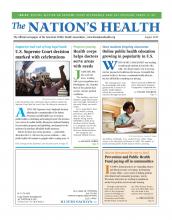Warnings about the sun’s harmful effects are seemingly everywhere, but a recent federal study finds that most young adults are not paying attention.
Published May 11 in the Centers for Disease Control and Prevention’s Morbidity and Mortality Weekly Report, the analysis found that most 18- to 29-year-olds do not regularly use protection when they are out in the sun. Although the number of young adults using sunscreen, shade and protective clothing has increased in recent years, the prevalence of sunburn remains high among 18 to 29-year-olds, with slightly more than half reporting at least one sunburn in the past 12 months.
Analyzing data from the National Health Interview Survey, researchers found that the most common sun-protective behaviors reported by young women in 2010 were sunscreen and shade, while the least common were wearing wide-brimmed hats and long-sleeved shirts. White women were less likely to report seeking shade, and black women were less likely to report using sunscreen as compared with women of other races.
Among men, wearing ankle-length clothing was the most common sun-protective behavior reported in 2010, followed by staying in the shade and using sunscreen. Wearing wide-brimmed hats and long-sleeved shirts were the least common sun protections used by young adult men.
While the study found the prevalence of sunburn to be about equal for both sexes, the numbers vary widely by race. In 2010, for example, 65.6 percent of whites ages 18 to 29 reported nursing a sunburn, as compared with only 10.9 percent of blacks in the same age group. Failure to protect skin with sunscreen, shade or clothing — such as long-sleeved pants, shirts and hats — greatly increases the risk of developing skin cancer.
“These results suggest that additional efforts are needed to identify and implement effective strategies targeting younger adults to improve their sun protective behaviors and prevent sunburn and ultimately skin cancer,” the study’s authors wrote.
According to CDC, exposure to ultraviolet radiation and a history of sunburn are preventable risk factors for skin cancer, which is the most common form of cancer in the United States. To protect against skin cancer, CDC recommends seeking shade — especially during the middle of the day — as well as wearing a wide-brimmed hat, clothing that protects exposed skin, sunglasses and sunscreen that has a sun protection factor of 15 or higher.
More than 3.5 million skin cancer cases affecting 2 million people are diagnosed annually in the United States, according to the American Academy of Dermatology. To increase the public’s understanding of skin cancer and motivate people to change their behaviors, the organization recently launched Spot Skin Cancer. Online at www.SpotSkinCancer.org, the public awareness campaign focuses on the positive actions people can take to protect themselves and their families from skin cancer. For example, the campaign teaches how to perform skin self-exams and offers body mole maps that can be downloaded free and used to track skin changes. Other resources include information about where to find free skin cancer screenings. People affected by skin cancer can also can share their stories via the website and download free materials to educate others in their communities.
To download the study, visit http://www.cdc.gov/mmwr/preview/mmwrhtml/mm6118a1.htm?s_cid=mm6118a1_w. For more information about skin cancer, visit www.cdc.gov/cancer/skin.
- Copyright The Nation’s Health, American Public Health Association









